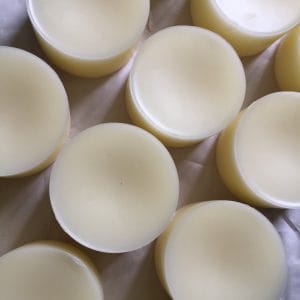
With the continuing drive to reduce single use plastic, solid conditioner bars have become more and more popular in recent months. I started experimenting with mine sometime last year, but the development / certification process can be a long one, and it wasn’t until the 2nd of October that I received the *Cosmetic Product Safety Assessment (CPSR) which meant I could finally offer solid conditioner bars to the public (and you can be sure that they’re perfectly safe to use)
So what are they made of?
Here’s the full ingredients list for the unscented version. Beneath I’ll give the same list in plain English.
BTMS25 (Behentrimonium Methosulfate, Cetearyl Alcohol), Cetyl Alcohol, Cocos Nucifera (Coconut) Oil, Simmondsia Chinensis (Jojoba) Seed Oil, Glycerin, Butyrospermum Parkii (Shea) Butter, Phenoxyethanol,
Plain English:
BTMS25 (Behentrimonium Methosulfate, Cetearyl Alcohol), Cetyl Alcohol, Coconut Oil, Jojoba Oil, Glycerin, Shea Butter, Preservative (Phenoxyethanol)
The chances are some of these ingredients will be unfamiliar to you. It’s possible that they might even ring alarm bells and I’m guessing that the ones that may cause concern are BTMS25 (Behentrimonium Methosulfate, Cetearyl Alcohol), Cetyl Alcohol and Preservative, so let me address these in turn.
1 Behentrimonium Methosulfate
Unfamiliar though this sounds, don’t be alarmed into lumping this sulfate with the ‘bad guys’ (eg sodium lauryl sulfate SLS) It’s a gentle surfectant, non irritating to the scalp, and one of the mildest (yet effective) detanglers, giving ‘slip’ to your hair after washing. Made from Rapeseed Oil.
2. Cetearyl Alcohol / Cetyl Alcohol
These are both fatty alcohols that occur naturally in plants and animals. I have been given a personal assurance from my supplier (The Soapery) that not only are the ones I use vegan friendly, they’re also palm free, being derived from coconut. They are used in conditioners for their emulsifying and moisturising properties.
3. Preservative (Phenoxyethanol)
Any solid conditioner MUST, by law, contain a preservative before it can be made available for sale. This is because once it comes into contact with water, there is the opportunity for bacterial, mould and yeast growth. Preservative or botulism? Regardless of the legalities, I know which I would choose. Phenoxyethanol has been called a ‘natural’ preservative, but this is a little misleading. It does appear in nature (in green tea, and chicory) but the one I use is a nature identical version created synthetically. It is free from parabens. This article gives a good, balanced overview of the use of Phenoxyethanol in cosmetic products.
The other ingredients (coconut and jojoba oils, shea butter and glycerin) are added for their moisturising properties.
I currently offer five varieties of the conditioner bars to match the shampoo bars: Unfragranced, Lemongrass & Spearmint, Tea Tree, Lavender & Sweet Orange and Mandarin & Bergamot. The ingredients are identical, other than the different essential oils ujsed to fragrance the bars.
*A CPSR is a legal requirement for ANY cosmetic / skin & body care product before it can be placed on the market in the European Union. Please make sure that any handmade product of this type has been certified before you make a purchase.
